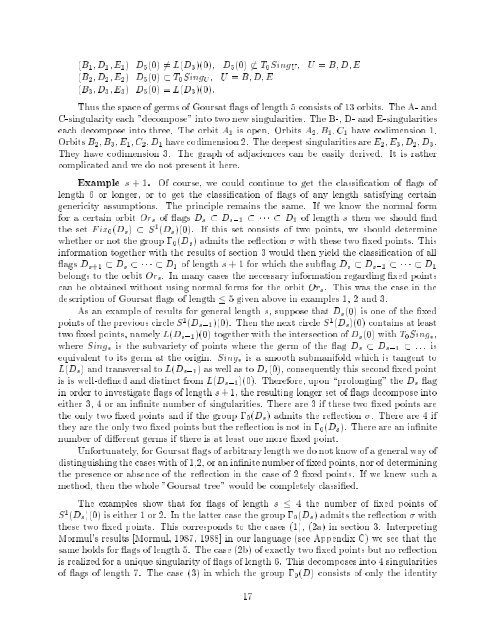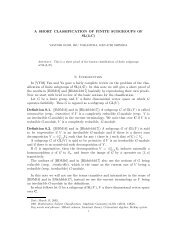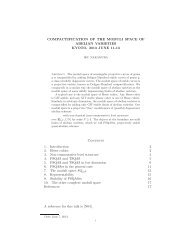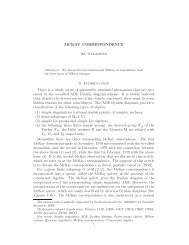GEOMETRIC APPROACH TO GOURSAT FLAGS * Richard ...
GEOMETRIC APPROACH TO GOURSAT FLAGS * Richard ...
GEOMETRIC APPROACH TO GOURSAT FLAGS * Richard ...
- No tags were found...
Create successful ePaper yourself
Turn your PDF publications into a flip-book with our unique Google optimized e-Paper software.
(B 1 D 1 E 1 ) D 5 (0) 6= L(D 3 )(0) D 5 (0) 6 T 0 Sing U U = BDE(B 2 D 2 E 2 ) D 5 (0) T 0 Sing U U = BDE(B 3 D 3 E 3 ) D 5 (0) = L(D 3 )(0).Thus the space of germs of Goursat ags of length 5 consists of 13 orbits. The A- andC-singularityeach "decompose" into two new singularities. The B-, D- and E-singularitieseach decompose into three. The orbit A 1 is open. Orbits A 2 B 1 C 1 have codimension 1.Orbits B 2 B 3 E 1 C 2 D 1 havecodimension 2. The deepest singularities are E 2 E 3 D 2 D 3 .They have codimension 3. The graph of adjaciences can be easily derived. It is rathercomplicated and we donot present ithere.Example s +1. Of course, we could continue to get the classication of ags oflength 6 or longer, or to get the classication of ags of any length satisfying certaingenericity assumptions. The principle remains the same. If we know the normal formfor a certain orbit Or s of ags D s D s;1 D 1 of length s then we should ndthe set Fix 0 (D s ) S 1 (D s )(0). If this set consists of two points, we should determinewhether or not the group ; 0 (D s ) admits the reection with these two xedpoints. Thisinformation together with the results of section 3 would then yield the classication of allags D s+1 D s D 1 of length s +1for which the subag D s D s;1 D 1belongs to the orbit Or s .Inmany cases the necessary information regarding xed pointscan be obtained without using normal forms for the orbit Or s . This was the case in thedescription of Goursat ags of length 5given above inexamples 1, 2 and 3.As an example of results for general length s, suppose that D s (0) is one of the xedpoints of the previous circle S 1 (D s;1 )(0). Then the next circle S 1 (D s )(0) contains at leasttwo xed points, namely L(D s;1 )(0) together with the intersection of D s (0) with T 0 Sing ,where Sing is the subvariety ofpoints where the germ of the ag D s D s;1 ::: isequivalent toits germ at the origin. Sing is a smooth submanifold which istangent toL(D s ) and transversal to L(D s;1 )aswell as to D s (0), consequently this second xed pointis is well-dened and distinct from L(D s;1 )(0). Therefore, upon \prolonging" the D s agin order to investigate ags of length s +1,the resulting longer set of ags decompose intoeither 3, 4 or an innite number ofsingularities. There are 3 if these two xedpoints arethe only two xed points and if the group ; 0 (D s )admits the reection . Thereare 4 ifthey are the only two xedpoints but the reection is not in ; 0 (D s ). There are an innitenumber ofdierent germs if there is at least one more xed point.Unfortunately, for Goursat ags of arbitrary length we donot knowofageneral wayofdistinguishing the cases with of 1,2, or an innite number of xed points, nor of determiningthe presence or absence of the reection in the case of 2 xed points. If we knew such amethod, then the whole "Goursat tree" would be completely classied.The examples show that for ags of length s 4thenumber of xed points ofS 1 (D s )(0) is either 1 or 2. In the latter case the group ; 0 (D s )admits the reection withthese two xed points. This corresponds to the cases (1), (2a) in section 3. InterpretingMormul's results [Mormul, 1987, 1988] in our language (see Appendix C) we see that thesame holds for ags of length 5. The case (2b) of exactly two xedpoints but no reectionis realized for a unique singularityofags of length 6. This decomposes into 4 singularitiesof ags of length 7. The case (3) in which the group ; 0 (D) consists of only the identity17





